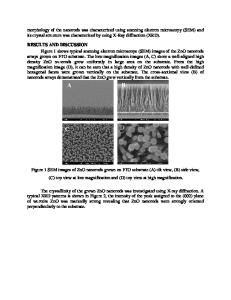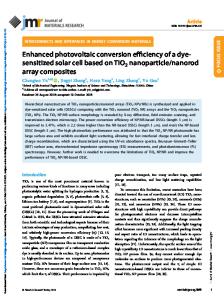High-Efficiency Dye-Sensitized Solar Cell Based on ZnO Nanorod Arrays Electrode
- PDF / 806,295 Bytes
- 5 Pages / 612 x 792 pts (letter) Page_size
- 34 Downloads / 319 Views
0974-CC07-10
High-Efficiency Dye-Sensitized Solar Cell Based on ZnO Nanorod Arrays Electrode Patcharee Charoensirithavorn and Susumu Yoshikawa Institute of Advanced Energy, Kyoto University, Uji, Kyoto, 6110011, Japan
ABSTRACT We have fabricated transparent ZnO nanorod arrays on the fluorine-doped SnO2 transparent conducting oxide (FTO) glass substrates and used them as the wide band gap semiconductor in dye-sensitized solar cells. Our objectives are to introduce and demonstrate new possibilities in designing the semiconductor morphology. The best performance with this cell structure produced an open circuit voltage (Voc) of 0.64 mV, a short circuit current density (Jsc) of 5.37 mA/cm2, a fill factor (FF) of 0.49, and conversion efficiency (η) of 1.69 %, primarily limited by the surface area of the nanorod array. INTRODUCTION Solar cell is one of the most promising renewable energy technologies for this century because it has possibility for solving environmental problems and insufficient energy problem. Dye-sensitized solar cell (DSSC) using inorganic semiconductor is being studied as a new type of solar cell and expected as a low cost alternative to conventional solid-state device. One important limiting factor in the DSSC cell performance is electron transport. During its traversal to the photoelectrode, an electron is estimated to cross 103 to 106 nanoparticles [1]. The replacing of the nanoparticle film with an array of oriented single-cryatalline nanorod offers the potential for improved electron transport leading to higher photoefficiencies. The pathways provided by the nanorods ensure the rapid collection of carriers generated throughout the device as the nanorod provides a direct path from the point of photogeneration to the conducting substrate. Moreover, electron transport in the crystalline rod is expected to be several orders of magnitude faster than percolation through a random polycrystalline network [2] In this study, high surface area ZnO nanorods array with different nanorod length has been synthesized, which shows high performance in dye-sensitized solar cell. The detail microstructure and photovoltaic properties will be reported. . EXPERIMENT Synthesis Arrays of ZnO nanorods were chemically synthesized on fluorine-doped SnO2 transparent conducting oxide glass substrate (FTO). The procedure consists of two steps. Firstly, zinc acetate in ethanol solution was dropped onto substrates by spin coating, and then the substrates were dried and annealed in order to form the nanocrystal seeds on the substrates. Secondly, vertical ZnO nanorod arrays from the nanocrystal seeds were grown by immersing the seeded substrates in precursor solution containing Zn(NO3)2 and NaOH at 110oC with different
growth time interval. Finally, the samples were washed by deionized water and dried in air. Characterization The crystalline structure of the samples was evaluated by X-ray diffraction (XRD, RIGAKU RINT 2100). The microstructure of the prepared materials was analyzed by scanning electron microscopy (SEM, JEOL JSM
Data Loading...











